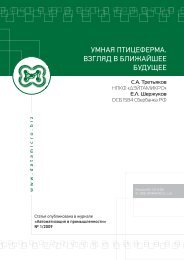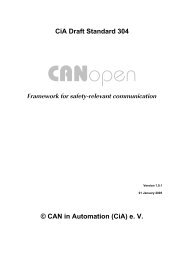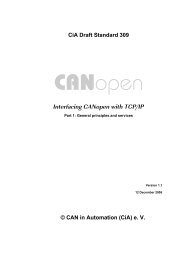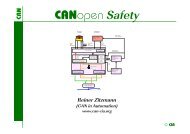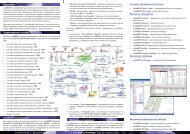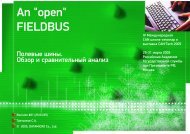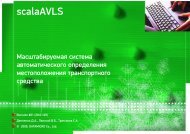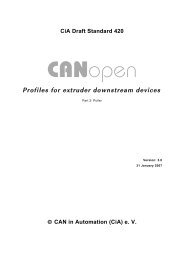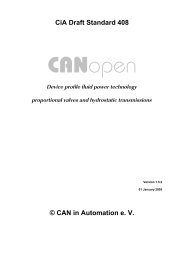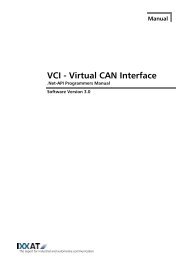Interfacing CANopen with TCP/IP
Interfacing CANopen with TCP/IP
Interfacing CANopen with TCP/IP
Create successful ePaper yourself
Turn your PDF publications into a flip-book with our unique Google optimized e-Paper software.
CiA Draft Standard 309<br />
<strong>CANopen</strong><br />
<strong>Interfacing</strong> <strong>CANopen</strong> <strong>with</strong> <strong>TCP</strong>/<strong>IP</strong><br />
Part 3: ASCII mapping<br />
Version 1.1<br />
12 December 2006<br />
© CAN in Automation (CiA) e. V.
CiA 309-3 <strong>Interfacing</strong> <strong>CANopen</strong> <strong>with</strong> <strong>TCP</strong>/<strong>IP</strong> – Part 3: ASCII mapping Version 1.1<br />
HISTORY<br />
Date<br />
Changes<br />
2004-09-15 Publication of version 1.0 as draft standard proposal<br />
2006-12-12 Publication of version 1.1 as draft standard<br />
Minor editorial corrections and clarifications.<br />
General information on licensing and patents<br />
CAN in AUTOMATION (CiA) calls attention to the possibility that some of the elements of<br />
this CiA specification may be subject of patent rights. CiA shall not be responsible for identifying<br />
any or all such patent rights.<br />
Because this specification is licensed free of charge, there is no warranty for this specification,<br />
to the extent permitted by applicable law. Except when otherwise stated in writing the<br />
copyright holder and/or other parties provide this specification “as is” <strong>with</strong>out warranty of<br />
any kind, either expressed or implied, including, but not limited to, the implied warranties of<br />
merchantability and fitness for a particular purpose. The entire risk as to the correctness<br />
and completeness of the specification is <strong>with</strong> you. Should this specification prove failures,<br />
you assume the cost of all necessary servicing, repair or correction.<br />
© CiA 2006<br />
All rights reserved. Unless otherwise specified, no part of this publication may be reproduced or utilized in any form or by<br />
any means, electronic or mechanical, including photocopying and microfilm, <strong>with</strong>out permission in writing from CiA at the<br />
address below.<br />
CAN in Automation e. V.<br />
Am Weichselgarten 26<br />
DE - 91058 Erlangen, Germany<br />
Tel.: +49-9131-69086-0<br />
Fax: +49-9131-69086-79<br />
Url: www.can-cia.org<br />
Email: headquarters@can-cia.org<br />
- ii -
CiA 309-3 <strong>Interfacing</strong> <strong>CANopen</strong> <strong>with</strong> <strong>TCP</strong>/<strong>IP</strong> – Part 3: ASCII mapping Version 1.1<br />
Contents<br />
1 Scope..................................................................................................................................................5<br />
2 References .........................................................................................................................................5<br />
3 Abbreviations and definitions............................................................................................................5<br />
3.1 Abbreviations...............................................................................................................................5<br />
3.2 Definitions....................................................................................................................................5<br />
3.2.1 General ...........................................................................................................................5<br />
3.2.2 Command structure .......................................................................................................6<br />
4 Network access command specification ..........................................................................................8<br />
4.1 SDO access commands.............................................................................................................8<br />
4.1.1 General ...........................................................................................................................8<br />
4.1.2 Upload SDO command..................................................................................................8<br />
4.1.3 Download SDO command.............................................................................................8<br />
4.1.4 Configure SDO timeout command................................................................................9<br />
4.2 PDO access commands.............................................................................................................9<br />
4.2.1 General ...........................................................................................................................9<br />
4.2.2 Configure RPDO command...........................................................................................9<br />
4.2.3 Configure TPDO command ...........................................................................................9<br />
4.2.4 Read PDO data command ......................................................................................... 10<br />
4.2.5 Write PDO data command ......................................................................................... 10<br />
4.2.6 RPDO received command.......................................................................................... 10<br />
4.3 <strong>CANopen</strong> NMT commands ..................................................................................................... 10<br />
4.3.1 General ........................................................................................................................ 10<br />
4.3.2 Start node command .................................................................................................. 10<br />
4.3.3 Stop node command................................................................................................... 10<br />
4.3.4 Set node to pre-operational command ...................................................................... 10<br />
4.3.5 Reset node command................................................................................................. 11<br />
4.3.6 Reset communication command................................................................................ 11<br />
4.3.7 Enable node guarding command ............................................................................... 11<br />
4.3.8 Disable node guarding command .............................................................................. 11<br />
4.3.9 Start heartbeat consumer command ......................................................................... 11<br />
4.3.10 Disable heartbeat consumer command..................................................................... 11<br />
4.3.11 Error control event received command ..................................................................... 11<br />
4.4 Device failure management commands................................................................................. 12<br />
4.4.1 General ........................................................................................................................ 12<br />
4.4.2 Read device error command...................................................................................... 12<br />
4.4.3 Emergency event received command ....................................................................... 12<br />
4.5 <strong>CANopen</strong> interface configuration commands ........................................................................ 12<br />
4.5.1 General ........................................................................................................................ 12<br />
4.5.2 Initialize gateway command ....................................................................................... 12<br />
4.5.3 Store configuration command .................................................................................... 12<br />
4.5.4 Restore configuration command ................................................................................ 13<br />
- iii -
CiA 309-3 <strong>Interfacing</strong> <strong>CANopen</strong> <strong>with</strong> <strong>TCP</strong>/<strong>IP</strong> – Part 3: ASCII mapping Version 1.1<br />
4.5.5 Set heartbeat producer command ............................................................................. 13<br />
4.5.6 Set node-ID command................................................................................................ 13<br />
4.5.7 Start emergency consumer command ...................................................................... 13<br />
4.5.8 Stop emergency consumer command....................................................................... 13<br />
4.6 Gateway management commands......................................................................................... 13<br />
4.6.1 General ........................................................................................................................ 13<br />
4.6.2 Set default network command.................................................................................... 13<br />
4.6.3 Set default node-ID command ................................................................................... 13<br />
4.6.4 Get version command................................................................................................. 13<br />
4.7 Controller management commands ....................................................................................... 14<br />
4.7.1 General ........................................................................................................................ 14<br />
4.7.2 Reset controller command ......................................................................................... 14<br />
4.7.3 Start controller command ........................................................................................... 14<br />
4.7.4 Stop controller command............................................................................................ 14<br />
4.8 Manufacturer-specific commands........................................................................................... 14<br />
4.8.1 General ........................................................................................................................ 14<br />
- iv -
CiA 309-3 <strong>Interfacing</strong> <strong>CANopen</strong> <strong>with</strong> <strong>TCP</strong>/<strong>IP</strong> – Part 3: ASCII mapping Version 1.1<br />
1 Scope<br />
This specification specifies the services and protocols to interface <strong>CANopen</strong> networks to a <strong>TCP</strong>/<strong>IP</strong>based<br />
network.<br />
This set of specifications is organized as follows:<br />
• Part 1: General principles and services<br />
• Part 2: Modbus/<strong>TCP</strong> mapping<br />
• Part 3: ASCII mapping<br />
This part of the specification defines the ASCII-based communication syntax for <strong>CANopen</strong> gateway<br />
devices. The aim is to provide a lightweight counterpart to solutions <strong>with</strong> CORBA or OPC.<br />
2 References<br />
The references given in part 1 shall apply to this part, too.<br />
7CiA301/<br />
/CiA309-1/<br />
CiA 301, <strong>CANopen</strong> application layer and communication profile<br />
CiA 309:2006, <strong>Interfacing</strong> <strong>CANopen</strong> <strong>with</strong> <strong>TCP</strong>/<strong>IP</strong> – Part 1: General principles and<br />
services (V1.1)<br />
/ISO/IEC 646/ ISO/IEC 646, 1991 Information technology – ISO 7-bit coded character set for information<br />
interchange<br />
/ISO/IEC 9899/ ISO/IEC 9899, 1999<br />
/RFC 2045/<br />
Programming languages – C<br />
RFC 2045 Multipurpose internet mail extensions<br />
3 Abbreviations and definitions<br />
3.1 Abbreviations<br />
The abbreviations given in part 1 shall apply to this part, too.<br />
ASCII<br />
BNF<br />
CPU<br />
CR<br />
CRLF<br />
LF<br />
3.2 Definitions<br />
3.2.1 General<br />
American Standard Code for Information Interchange<br />
Backus Naur form<br />
Central Processing Unit<br />
Carriage Return<br />
Carriage Return and Line Feed<br />
Line Feed<br />
The definitions given in part 1 shall apply to this part, too.<br />
Command<br />
controls the gateway and interacts <strong>with</strong> <strong>CANopen</strong> devices. It may have a long form and a short<br />
form. The short form is a one or two letter abbreviation of the long form. The long form is obtained<br />
by concatenating the short form and the string enclosed in brackets “[“, “]”.<br />
Note: In the given examples it is assumed that network address and node address are preset.<br />
Data type syntax<br />
The mandatory data types shall be supported.<br />
Table 1: Syntax and <strong>CANopen</strong> data types<br />
Syntax <strong>CANopen</strong> Type Category<br />
b Boolean Mandatory<br />
u8 Unsigned8 Mandatory<br />
u16 Unsigned16 Mandatory<br />
- 5 -
CiA 309-3 <strong>Interfacing</strong> <strong>CANopen</strong> <strong>with</strong> <strong>TCP</strong>/<strong>IP</strong> – Part 3: ASCII mapping Version 1.1<br />
Syntax <strong>CANopen</strong> Type Category<br />
u24 Unsigned24 Optional<br />
u32 Unsigned32 Mandatory<br />
u40 Unsigned40 Optional<br />
u48 Unsigned48 Optional<br />
u56 Unsigned56 Optional<br />
u64 Unsigned64 Optional<br />
i8 Integer8 Mandatory<br />
i16 Integer16 Mandatory<br />
i24 Integer24 Optional<br />
i32 Integer32 Mandatory<br />
i40 Integer40 Optional<br />
i48 Integer48 Optional<br />
i56 Integer56 Optional<br />
i64 Integer64 Optional<br />
r32 Real32 Optional<br />
r64 Real64 Optional<br />
t Time of day (<strong>with</strong> two arguments: day ms) Optional<br />
td Time difference Optional<br />
vs Visible string Optional<br />
os Octet string Optional<br />
us Unicode string Optional<br />
d Domain Optional<br />
The value of the data type domain, octet string, and unicode string shall be encoded in mimebase64<br />
as specified in /RFC 2045/. All wrapping CRLF shall be stripped from the encoded data to<br />
have one long string.<br />
whitespace<br />
As specified in /ISO/IEC 9899/ except of CR and LF.<br />
Note: A visible string <strong>with</strong> whitespace is enclosed <strong>with</strong> double quotes to denote it as single argument<br />
of the command. If a double quote is used <strong>with</strong>in the string, the quotes are escaped by a second<br />
quotes, e.g. “Hello “”World””, <strong>CANopen</strong> is great”.<br />
3.2.2 Command structure<br />
The principle communication is based on non-case-sensitive ASCII strings /ISO/IEC 646/ instead of<br />
architecture and CPU/compiler depending binary structures. Due to this, no application handles<br />
<strong>with</strong> things like endianness, data size and byte alignment. In all cases where numbers are used,<br />
the typical representation like specified in /ISO/IEC 9899/.<br />
100 - decimal, starting <strong>with</strong> a number<br />
0x64<br />
1.22 - float<br />
.22e10 - float<br />
22e3<br />
3.2.2.1 Request<br />
- hexadecimal, starting <strong>with</strong> the string 0x<br />
- float<br />
The <strong>CANopen</strong> gateway is controlled by commands. A command is composed of tokens, which are<br />
separated by any number of whitespaces and is closed <strong>with</strong> a CRLF.<br />
- 6 -
CiA 309-3 <strong>Interfacing</strong> <strong>CANopen</strong> <strong>with</strong> <strong>TCP</strong>/<strong>IP</strong> – Part 3: ASCII mapping Version 1.1<br />
All commands are confirmed. Commands start <strong>with</strong> a sequence number which is enclosed by<br />
square brackets [ ]. The sequence number is a 4-byte value. It is not used for event-triggered messages.<br />
According to the addressing principle, a network number and a node number follow the<br />
sequence number. Network number and node number are optional, when the <strong>CANopen</strong> gateway<br />
only provides one Ethernet/CAN interface or when a client presets them. Commands that affect<br />
only the server not a remote node but a net and node are given net and node are ignored. In BNF<br />
notation a command defines as follows:<br />
<br />
<br />
<br />
<br />
<br />
<br />
<br />
::= "[""]" [[] ] <br />
::= UNSIGNED32<br />
::= UNSIGNED8<br />
::= UNSIGNED8<br />
::= | <br />
::= <br />
::= | <br />
::= <br />
<br />
::= | <br />
::= ‘b’ | ‘u8’ | ‘u16’ | ‘u32’ | ‘u40’ | ‘u48’ |<br />
‘u56’ | ‘u64’ | ‘i8’ | ‘i16’ | ‘i24’ | ‘i32’ |<br />
‘i40’ | ‘i48’ | ‘i56’ | ‘i64’ | ‘r32’ | ‘r64’ |<br />
‘t’ | ‘td’ | ‘vs’ | ‘os’ | ‘us’ | ‘d’<br />
<br />
<br />
<br />
::= <br />
::= UNSIGNED16<br />
::= UNSIGNED8<br />
Net numbers are starting <strong>with</strong> 1. Node numbers are starting <strong>with</strong> 1. The value 0 for net or node is<br />
used to address all networks or all nodes.<br />
The token designates a value of the possible <strong>CANopen</strong> data types.<br />
Within the description of the commands the sequence number is omitted for reasons of readability.<br />
3.2.2.2 Response<br />
The <strong>CANopen</strong> gateway shall respond <strong>with</strong> the same sequence number at the first position as given<br />
by the request. This number shall be given in decimal format. There shall be only one response to<br />
a request.<br />
<br />
<br />
<br />
<br />
| "OK"<br />
::= "[""]" <br />
::= | | <br />
::= "Error:" <br />
::= see table 2<br />
<br />
<br />
::= | <br />
::= UNSIGNED32<br />
::= [ " "..]<br />
The sdo-abort-codes (SAC) are defined in /CiA301/. Allowed internal-error-codes (IEC) are listed in<br />
Table 2:<br />
IEC<br />
Table 2 - Internal error code<br />
Message text<br />
100 Request not supported<br />
101 Syntax error<br />
102 Request not processed due to internal state<br />
- 7 -
CiA 309-3 <strong>Interfacing</strong> <strong>CANopen</strong> <strong>with</strong> <strong>TCP</strong>/<strong>IP</strong> – Part 3: ASCII mapping Version 1.1<br />
103 Time-out (where applicable)<br />
200 Lost guarding message<br />
201 Lost connection<br />
202 Heartbeat started<br />
203 Heartbeat lost<br />
205 Boot-up<br />
300 Error passive<br />
301 Bus off<br />
303 CAN buffer overflow<br />
304 CAN init<br />
305 CAN active (at init or start-up)<br />
400 PDO already used<br />
401 PDO length exceeded<br />
Note: After bus-off, the command init should be invoked to reset the CAN controller.<br />
3.2.2.3 Event triggered messages<br />
Messages due to errors in the <strong>CANopen</strong> network or the occurrence of communication objects using<br />
the producer-consumer principle shall not use a sequence number.<br />
::= [[net] node] <br />
<br />
::= "EMCY" | "ERROR" | "PDO" | "SYNC" | "USER"<br />
The content of event-triggered messages is described <strong>with</strong>in the command description that enables<br />
the specific service.<br />
4 Network access command specification<br />
4.1 SDO access commands<br />
4.1.1 General<br />
The following command definitions shall be used to implement the SDO access services as defined<br />
in part 1.<br />
SDO access services are addressing a specific object at an SDO server via index and sub-index<br />
and a transfer data type.<br />
4.1.2 Upload SDO command<br />
Indication syntax:<br />
[[net] node] r[ead] <br />
Examples:<br />
[21] r 0x1000 0 u32<br />
[4096] read 0x1008 0 vs<br />
Response syntax:<br />
See chapter 3.2.2.2<br />
4.1.3 Download SDO command<br />
Indication syntax:<br />
[[net] node] w[rite] <br />
Examples:<br />
[20] 1 23 w 0x1016 0 u16 100<br />
- 8 -
CiA 309-3 <strong>Interfacing</strong> <strong>CANopen</strong> <strong>with</strong> <strong>TCP</strong>/<strong>IP</strong> – Part 3: ASCII mapping Version 1.1<br />
[23] write 0x1016 0 u16 0x64<br />
Response syntax:<br />
See chapter 3.2.2.2<br />
4.1.4 Configure SDO timeout command<br />
The timeout delay time for abort error code ‘SDO protocol timed out’, used by the gateway’s SDO<br />
client, may be set.<br />
Indication syntax:<br />
[net] set sdo_timeout <br />
Response syntax:<br />
See chapter 3.2.2.2<br />
4.2 PDO access commands<br />
4.2.1 General<br />
The following command definitions shall be used to implement the PDO access services as defined<br />
in part 1. Normally a PDO is first configured before transmission and reception is possible.<br />
A PDO is seen from the view of the gateway. An RPDO therefore receives data from the <strong>CANopen</strong><br />
network and a TPDO sends the data into the <strong>CANopen</strong> network.<br />
Note: In order to disable/delete a gateway PDO, the bit 31 in the COB-ID is used. For details see<br />
/CiA301/.<br />
4.2.2 Configure RPDO command<br />
Indication syntax:<br />
[[net] node] set rpdo <br />
[..]<br />
::= "rtr" | "event" | "sync"<br />
Note: In case a is given in form of index and subindex, i.e. , they<br />
are counted as 1 in the . The is an offset; it starts <strong>with</strong> 1.<br />
Example:<br />
[12] set rpdo 1 0x180 event 3 u8 u8 u16<br />
[24] 2 set rpdo 1 0x180 event 3 u8 u8 i16<br />
Response syntax:<br />
See chapter 3.2.2.2<br />
4.2.3 Configure TPDO command<br />
Indication syntax:<br />
[[net] node] set tpdo <br />
[..]<br />
Note: In case a is given in form of index and subindex, i.e. , they<br />
are counted as 1 in the . The is an offset; it starts <strong>with</strong> 1.<br />
Example:<br />
[13] set tpdo 1 0x201 rtr 4 u8 u16 u16 u8<br />
Response syntax:<br />
See chapter 3.2.2.2<br />
Note: It is not recommended to support RTR. Therefore it is recommended to set bit 30 of the<br />
COB-ID accordingly. For details see /CiA301/.<br />
- 9 -
CiA 309-3 <strong>Interfacing</strong> <strong>CANopen</strong> <strong>with</strong> <strong>TCP</strong>/<strong>IP</strong> – Part 3: ASCII mapping Version 1.1<br />
4.2.4 Read PDO data command<br />
Indication syntax:<br />
[net] r[ead] p[do] <br />
If the transmission type is different than RTR, the gateway answers <strong>with</strong> the values of the mapped<br />
objects.<br />
Response syntax:<br />
[net] pdo [..]<br />
4.2.5 Write PDO data command<br />
Indication syntax:<br />
[net] w[rite] p[do] [..]<br />
Response syntax:<br />
See chapter 3.2.2.2<br />
4.2.6 RPDO received command<br />
Indication syntax:<br />
[net] pdo [..]<br />
Examples:<br />
1 pdo 1 2 123 4 ;# gateway <strong>with</strong> more than one network<br />
pdo 2 1 1234<br />
pdo 2 3 100 2 4<br />
4.3 <strong>CANopen</strong> NMT commands<br />
4.3.1 General<br />
;# received RPDO1 at net 1 <strong>with</strong> two objects<br />
;# mapped<br />
;# RPDO2 <strong>with</strong> one object mapped<br />
;# three objects mapped<br />
The following command definitions shall be used to implement the <strong>CANopen</strong> NMT services as defined<br />
in part 1. The supported services depend on the gateway class.<br />
4.3.2 Start node command<br />
Indication syntax:<br />
[[net] node] start<br />
Response syntax:<br />
See chapter 3.2.2.2<br />
4.3.3 Stop node command<br />
Indication syntax:<br />
[[net] node] stop<br />
Response syntax:<br />
See chapter 3.2.2.2<br />
4.3.4 Set node to pre-operational command<br />
Indication syntax<br />
[[net] node] preop[erational]<br />
Response syntax:<br />
See chapter 3.2.2.2<br />
- 10 -
CiA 309-3 <strong>Interfacing</strong> <strong>CANopen</strong> <strong>with</strong> <strong>TCP</strong>/<strong>IP</strong> – Part 3: ASCII mapping Version 1.1<br />
4.3.5 Reset node command<br />
Indication syntax:<br />
[[net] node] reset node<br />
Response syntax:<br />
See chapter 3.2.2.2<br />
4.3.6 Reset communication command<br />
Indication syntax:<br />
[[net] node] reset comm[unication]<br />
Response syntax:<br />
See chapter 3.2.2.2<br />
4.3.7 Enable node guarding command<br />
Activating node-guarding functionality enables another event-triggered response message to the<br />
clients of the gateway. Only in the case that one of the monitored <strong>CANopen</strong> nodes violates the<br />
guarding protocol, an event message shall be sent to the clients.<br />
Indication syntax:<br />
[[net] node] enable guarding <br />
Response syntax:<br />
See chapter 3.2.2.2<br />
4.3.8 Disable node guarding command<br />
Indication syntax:<br />
[[net] node] disable guarding<br />
Response syntax:<br />
See chapter 3.2.2.2<br />
4.3.9 Start heartbeat consumer command<br />
Activating the heartbeat consumer at the gateway enables another event-triggered response message<br />
to the gateway’s clients. Only in the case that one of the monitored <strong>CANopen</strong> nodes violates<br />
the guarding protocol, an event message shall be sent to the clients.<br />
Indication syntax:<br />
[[net] node] enable heartbeat <br />
Response syntax:<br />
See chapter 3.2.2.2<br />
4.3.10 Disable heartbeat consumer command<br />
Indication syntax:<br />
[[net] node] disable heartbeat<br />
Response syntax:<br />
See chapter 3.2.2.2<br />
4.3.11 Error control event received command<br />
Response syntax:<br />
[[net] node] ERROR <br />
- 11 -
CiA 309-3 <strong>Interfacing</strong> <strong>CANopen</strong> <strong>with</strong> <strong>TCP</strong>/<strong>IP</strong> – Part 3: ASCII mapping Version 1.1<br />
4.4 Device failure management commands<br />
4.4.1 General<br />
The following command definitions shall be used to implement the device failure management<br />
services as defined in part 1.<br />
4.4.2 Read device error command<br />
Indication syntax:<br />
[[net] node] r[ead] error<br />
Response syntax:<br />
See chapter 3.2.2.2<br />
4.4.3 Emergency event received command<br />
Response syntax:<br />
[[net] node] EMCY <br />
The m(anufacturer)-error-code shall be returned as five decimal values corresponding to the manufacturer-specific<br />
error code in the EMCY message.<br />
4.5 <strong>CANopen</strong> interface configuration commands<br />
4.5.1 General<br />
The following command definitions shall be used to implement the <strong>CANopen</strong> interface configuration<br />
services as defined in part 1. Settings are valid for the default network, if no network address is<br />
given. The node address shall be omitted, in case it is given.<br />
4.5.2 Initialize gateway command<br />
Indication syntax:<br />
[net] init <br />
The bit-rate shall be given as table index of the standard <strong>CANopen</strong> bit-rate table specified in /CiA<br />
305/.<br />
Response syntax:<br />
See chapter 3.2.2.2<br />
4.5.3 Store configuration command<br />
All settings may be stored. Storage of settings may be selective to a special service. If no argument<br />
is given all settings shall be stored.<br />
Indication syntax<br />
[net] store <br />
Table 3 - Storage specifier<br />
Storage specifier<br />
Description<br />
CFG id, bitrate, default node, default net<br />
PDO PDO-number, transmission type, number of mapping, mapping<br />
SDO sdo timeout<br />
NMT - Node guarding: node, guarding time, life time factor<br />
- Heartbeat: node, heartbeat time<br />
- Heartbeat time of the server<br />
Response syntax:<br />
See chapter 3.2.2.2<br />
- 12 -
CiA 309-3 <strong>Interfacing</strong> <strong>CANopen</strong> <strong>with</strong> <strong>TCP</strong>/<strong>IP</strong> – Part 3: ASCII mapping Version 1.1<br />
4.5.4 Restore configuration command<br />
Indication syntax:<br />
[net] restore <br />
Response syntax:<br />
See chapter 3.2.2.2<br />
4.5.5 Set heartbeat producer command<br />
Indication syntax<br />
[net] set heartbeat <br />
Response syntax:<br />
See chapter 3.2.2.2<br />
4.5.6 Set node-ID command<br />
Indication syntax<br />
[net] set id <br />
Response syntax:<br />
See chapter 3.2.2.2<br />
4.5.7 Start emergency consumer command<br />
This command is not specified.<br />
4.5.8 Stop emergency consumer command<br />
This command is not specified.<br />
4.6 Gateway management commands<br />
4.6.1 General<br />
The following command definitions shall be used to implement the gateway management services<br />
as defined in part 1.<br />
4.6.2 Set default network command<br />
Indication syntax<br />
[net] set network <br />
Response syntax:<br />
See chapter 3.2.2.2<br />
4.6.3 Set default node-ID command<br />
Indication syntax<br />
[net] set node <br />
Response syntax:<br />
See chapter 3.2.2.2<br />
4.6.4 Get version command<br />
Indication syntax:<br />
info version<br />
The command responses the current version information of the gateway as a whitespace separated<br />
list. The first list elements are values normally contained in the gateway’s object dictionary at<br />
object 1018 h . The following list elements containing the gateway class, as a combination of possible<br />
classes and the version number of the implemented protocol corresponded to part 1.<br />
Response syntax:<br />
- 13 -
CiA 309-3 <strong>Interfacing</strong> <strong>CANopen</strong> <strong>with</strong> <strong>TCP</strong>/<strong>IP</strong> – Part 3: ASCII mapping Version 1.1<br />
::= <br />
Result example:<br />
. <br />
<br />
<br />
[1234] 52 100 1.01 1234567 128 0.85 0.10<br />
4.7 Controller management commands<br />
4.7.1 General<br />
The following command definitions shall be used to implement the controller management services<br />
as defined in part 1.<br />
4.7.2 Reset controller command<br />
This command is not specified.<br />
4.7.3 Start controller command<br />
This command is not specified.<br />
4.7.4 Stop controller command<br />
This command is not specified.<br />
4.8 Manufacturer-specific commands<br />
4.8.1 General<br />
The following command definitions shall be used to implement the manufacturer-specific services.<br />
Gateway manufacturer may add commands to their gateway to provide further features. In order to<br />
avoid syntax errors due to an unknown command all user-specific commands shall be pre-pended<br />
<strong>with</strong> an underscore “_”.<br />
If there is the need for event-triggered messages not specified in this part of the specification the<br />
event specifier “USER” shall be used.<br />
- 14 -




